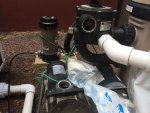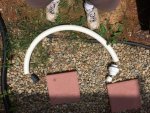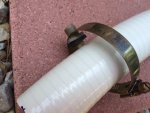Hi, I am about to install some flexible pipe connect my pump to my multiport valve and would like to confirm if the connections should be adequate.
Originally, the connections were made with rigid pipe, adapters, and a union. Both end points (at the pump and at the valve) were leaking and the only way to take the assembly off was to cut it. My goal is to replace it with a design that can be removed and put back on if I have leaks in the future. The two threaded openings are close but if I run the pipe vertically from the pipe and then turn it 270 degrees, the 4 foot section will just make it inline with the valve opening. Here is the equipment.

Here is the proposed setup: The white PVC adapter will screw into the pump, the union will be cemented to the adapter, the flexible pipe (Schedule 40 PVC flexpipe) will be cemented into the union, the other end will be clamped on to the ABS (?) barb (after the barb is screwed in). Plumbing tape on all threads.

My main concern is the flex pipe to the barb. I have seen some comments that barbs aren't really designed to work with flex pipe but I think I read some that indicated it can work. I'm amenable to a more full proof solution. Is there a PVC adapter with 1.5 inch thread to 1.5 inch smooth female opening?
I also need to reattach the chlorinator line. It was attached to the pump-to-valve PVC. I am wondering if using the metal band will work on flexible PVC pipe or if I need a different solution.

Many thanks for any suggestions.
Originally, the connections were made with rigid pipe, adapters, and a union. Both end points (at the pump and at the valve) were leaking and the only way to take the assembly off was to cut it. My goal is to replace it with a design that can be removed and put back on if I have leaks in the future. The two threaded openings are close but if I run the pipe vertically from the pipe and then turn it 270 degrees, the 4 foot section will just make it inline with the valve opening. Here is the equipment.

Here is the proposed setup: The white PVC adapter will screw into the pump, the union will be cemented to the adapter, the flexible pipe (Schedule 40 PVC flexpipe) will be cemented into the union, the other end will be clamped on to the ABS (?) barb (after the barb is screwed in). Plumbing tape on all threads.

My main concern is the flex pipe to the barb. I have seen some comments that barbs aren't really designed to work with flex pipe but I think I read some that indicated it can work. I'm amenable to a more full proof solution. Is there a PVC adapter with 1.5 inch thread to 1.5 inch smooth female opening?
I also need to reattach the chlorinator line. It was attached to the pump-to-valve PVC. I am wondering if using the metal band will work on flexible PVC pipe or if I need a different solution.

Many thanks for any suggestions.

